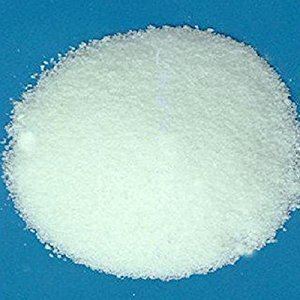Related compounds IUPAC ID Sodium chlorate Melting point 248 °C Soluble in Water | Formula NaClO3 Molar mass 106.44 g/mol Density 2.5 g/cm³ | |
 | ||
Appearance Colorless or white solid, hygroscopic | ||
Sodium chlorate
Sodium chlorate is an inorganic compound with the chemical formula NaClO3. It is a white crystalline powder that is readily soluble in water. It is hygroscopic. It decomposes above 300 °C to release oxygen and leave sodium chloride. Several hundred million tons are produced annually, mainly for applications in bleaching paper.
Contents
- Sodium chlorate
- Synthesis
- Uses
- Herbicides
- Chemical oxygen generation
- Toxicity in humans
- Formulations
- Trade names
- References
Synthesis
Industrially, sodium chlorate is produced by the electrolysis of a hot sodium chloride solution:
NaCl + 3 H2O → NaClO3 + 3 H2:This reaction progresses in heat (at least 70 degrees Celsius), and controlled pH. In lower temperature or with high pH another reaction progresses: 2 NaCl + H2O → NaClO + NaCl + H2
The Chloralkali process is an industrial process for the electrolytic production of sodium hydroxide and chlorine.
It can also be synthesized by passing chlorine gas through a solution of sodium hydroxide. It is then purified by crystallization.
Uses
The main commercial use for sodium chlorate is for making chlorine dioxide (ClO2). The largest application of ClO2, which accounts for about 95% of the use of chlorate, is in bleaching of pulp. All perchlorate compounds are produced industrially by the oxidation of solutions of sodium chlorate by electrolysis.
Herbicides
Sodium chlorate is used as a non-selective herbicide. It is considered phytotoxic to all green plant parts. It can also kill through root absorption.
Sodium chlorate may be used to control a variety of plants including morning glory, canada thistle, johnson grass, bamboo, Ragwort, and St John's wort. The herbicide is mainly used on non-crop land for spot treatment and for total vegetation control on areas including roadsides, fenceways, and ditches. Sodium chlorate is also used as a defoliant and desiccant for:
If used in combination with atrazine, it increases the persistence of the effect. If used in combination with 2,4-D, performance is improved. Sodium chlorate has a soil sterilant effect. Mixing with other herbicides in aqueous solution is possible to some extent, so long as they are not susceptible to oxidation.
Chemical oxygen generation
Chemical oxygen generators, such as those in commercial aircraft, provide emergency oxygen to passengers to protect them from drops in cabin pressure. Oxygen is generated by high-temperature decomposition of sodium chlorate. Heat is generated by oxidation of a small amount of iron powder mixed with the sodium chlorate, and the reaction consumes less oxygen than is produced. Barium peroxide (BaO2) is used to absorb the chlorine which is a minor product in the decomposition. An ignitor charge is activated by pulling on the emergency mask. Similarly, the Solidox welding system used pellets of sodium chlorate mixed with combustible fibers to generate oxygen.
Toxicity in humans
Due to its oxidative nature, sodium chlorate can be very toxic if ingested. The oxidative effect on hemoglobin leads to methaemoglobin formation, which is followed by denaturation of the globin protein and a cross-linking of erythrocyte membrane proteins with resultant damage to the membrane enzymes. This leads to increased permeability of the membrane, and severe hemolysis. The denaturation of hemoglobin overwhelms the capacity of the G6PD metabolic pathway. In addition, this enzyme is directly denatured by chlorate reducing its activity.
Therapy with ascorbic acid and methylene blue are frequently used in the treatment of methemoglobinemia. However, since methylene blue requires the presence of NADPH that requires normal functioning of G6PD system, it is less effective than in other conditions characterized by hemoglobin oxidation.
Acute severe hemolysis results, with multi-organ failure, including DIC and renal failure. In addition there is a direct toxicity to the proximal renal tubule. The treatment will consist of exchange transfusion, peritoneal dialysis or hemodialysis.
Formulations
Sodium chlorate comes in dust, spray and granule formulations. There is a risk of fire and explosion in dry mixtures with other substances, especially organic materials, and other herbicides, sulfur, phosphorus, powdered metals, and strong acids. In particular, when mixed with sugar, it has explosive properties. If accidentally mixed with one of these substances it should not be stored in human dwellings.
Marketed formulations contain a fire retardant, but this has little effect if deliberately ignited. Most commercially available chlorate weedkillers contain approximately 53% sodium chlorate with the balance being a fire depressant such as sodium metaborate or ammonium phosphates.
Trade names
Sodium chlorate is the active ingredient in a variety of commercial herbicides. Some trade names for products containing sodium chlorate include Atlacide, Defol, De-Fol-Ate, Drop-Leaf, Fall, Harvest-Aid, Kusatol, Leafex, and Tumbleaf. The compound may be used in combination with other herbicides such as atrazine, 2,4-D, bromacil, diuron, and sodium metaborate.
Sodium chlorate was an extensively used weedkiller within the EU, up until 2009 when it was withdrawn after a decision made under terms of EU Regulations. Its use as an herbicide outside the EU remains unaffected, as does its use in other non-herbicidal applications, such as in the production of chlorine dioxide biocides and for pulp and paper bleaching
